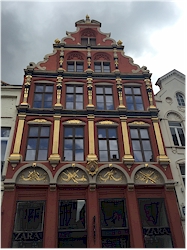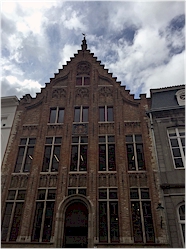|
Picture: Guild house of the masons |
|
» Eating » Sleeping facilities » Going out in Bruges » Fixed events » Beguinage » Belfry and halls » Chapel of the Holy Blood » Court of the Princes » Dunes abbey » Guild houses of Bruges » Hospices of Bruges » Jerusalem church » Nation houses » Our Ladies church » Poortersloge » St-Anna's church » St-Donatian's cathedral » St-John's hospital » St-Saviour's cathedral » Town gates » Town hall » Windmills of Bruges » Complete overview... » Archeology museum » Brangwyn museum » Brewery museum » Chocolate museum » Diamant museum » Folklore museum » Frites museum » Groeninghe museum » Guido Gezelle museum » Halve Maan » Lace museum » Lamps museum » Memling museum » Museum of Fine Arts » Salvador Dali museum » St-Janshuismill » St-John's hospital » Complete overview... » Boterhuis » Boudewijn Seapark » Burg » Canals (Reien) » Coupure » De Garre » Grote Markt » Historium » Huidevettersplein » Jan Van Eyckplein » Lake of Love (Minnewater) » Rozenhoedkaai » Simon Stevinplein » 't Zand » Complete overview...
|
The guild houses of Bruges
Guilds existed until the end of the 18th century. They were organizations that gathered traders or craftsmen of a certain profession. Before being able to become a member of a guild, one had to apply and complete an apprenticeship with a master. After that, the apprentice had to do a test after which he could be allowed to perform the craft. This way, they ensured the quality of the work.
Guilds decided who was and was not suitable for membership and could consequently refuse certain (groups of) people. They could also have the exclusivity to perform a craft in a city, leading to monopolies. Big guilds had extensive financial abilities but they also had political influence. You could say that in that way they were lobbies avant la lettre. It goes without saying that some guilds were very wealthy and displayed this in their houses. Below a few of the (former) guild
houses in Bruges: Picture 1: guildhouse of the
masons
|
» getting to Bruges » transport, tours, links,...
|
|
© xplorengo.com. Information is provided from the location and various sources, we do not hold any responsibility with regard to information provided by others. xplorengo is not a travel agency and does not promote or organize trips we therefore hold no responsibility with regard to third parties that promote their services via us. No information or pictures can be copied or distributed in any way without written permission of xplorengo.com. All pictures are made and copyrighted by Hendrik De Leyn unless mentioned otherwise [Contact information]. |

